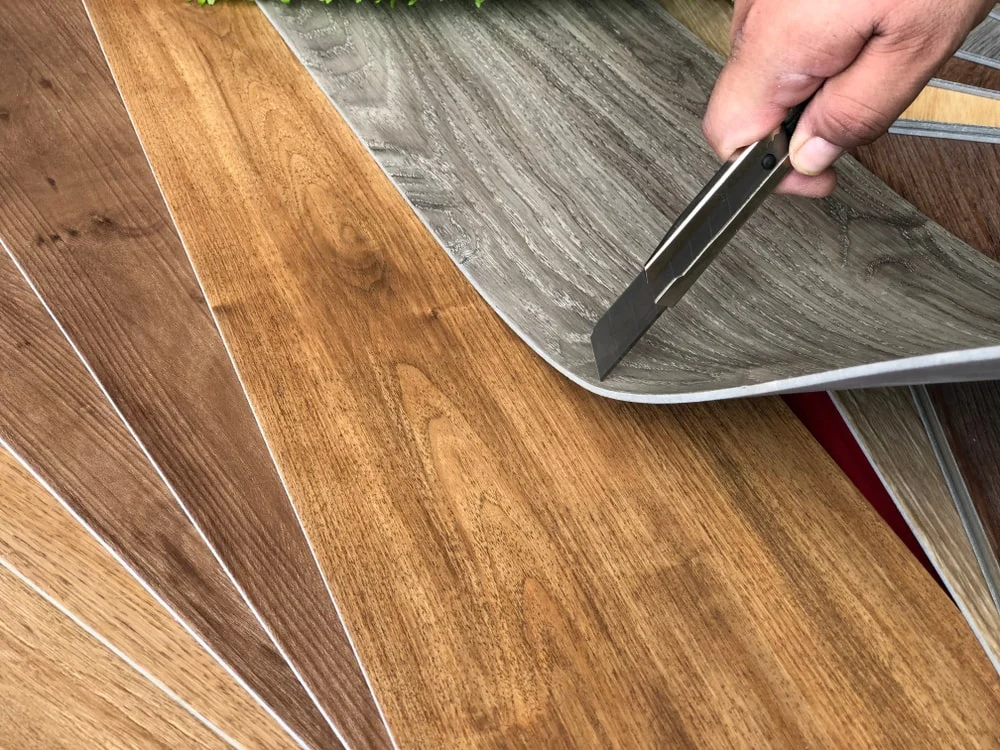Latest News
Everything You Need To Know About Vinyl Flooring Before You Buy

Vinyl flooring is a synthetic material favored for its durability and functionality. It has become an increasingly popular flooring material in recent years because of its ability to fight off moisture and its versatile appearance. Plus, it’s one of the most affordable flooring options. Vinyl flooring can realistically mimic wood, stone, marble and a vast array of other luxury flooring materials.
Vinyl flooring comprises several layers of materials. When pressed together, these materials form a water-resistant, long-lasting and relatively cheap covering for floors.
What’s In Vinyl Flooring?
Standard vinyl flooring usually consists of four layers of materials. The first, or bottom, layer of these is the backing layer, generally made of cork or foam. It is designed to serve as the underlayment for the vinyl flooring so that you do not have to install another material prior to laying down the vinyl flooring. Additionally, it functions as a cushion to make walking on the floor more comfortable and a sound barrier to keep noise at bay.
Above the backing layer sits the waterproof layer (assuming you are using waterproof vinyl). This layer is designed to absorb moisture without swelling or compromising the integrity of the floor. There are two types of waterproof layers: WPC, made from a wood and plastic deposit, and SPC, made from a stone and plastic deposit.
Above the waterproof layer is the design layer, which features a high-resolution printed image of your choosing. Many design layers are printed to resemble wood, marble, stone and other high-end materials.
Finally, there is the wear layer, which sits at the top of vinyl flooring and protects it from being harmed. High-traffic areas will need a thick wear layer in order to retain a long lifespan, while less walked-upon areas can handle a thinner wear layer.
Luxury vinyl flooring may have even more than four layers of materials, usually six to eight. These can include a clear top coat layer, which lends a sheen to the floor and provides extra protection for the wear layer, a cushion layer made of foam or felt engineered to make the floor comfortable to walk on and a fiberglass layer that supports the layers above it and helps the flooring lie as evenly and securely as possible.
Types of Vinyl Flooring
Vinyl Plank
Vinyl planks are designed to resemble hardwood floors and come in designs that mimic many varieties of wood. Many people choose from the various types of vinyl planks because unlike wood, vinyl planks are water-resistant, stain-resistant and easy to maintain. This type of vinyl flooring is best for high-traffic areas that are prone to wear-and-tear.
Vinyl Tile
Vinyl tiles are designed to resemble stone or ceramic tiles. Like vinyl planks, they come in a wide variety of patterns and colors that mimic their naturally occurring counterparts. When installing vinyl tiles, some people even add grout in order to more closely replicate the effect of stone or ceramic tiles. Many people favor vinyl tile for small areas of their home because unlike stone tiles, vinyl tiles can easily be cut in order to fit in small spaces.
Vinyl Sheet
Unlike vinyl planks and tiles, vinyl sheets come in rolls up to twelve feet wide and can be laid down in one fell swoop. Most people choose vinyl sheets for large areas of their homes because of its affordability and durability.
Luxury Vinyl Plank and Tile
With more layers than standard vinyl floors, luxury vinyl planks and tiles are around five times thicker than their counterparts. The additional material can lend a realism to the flooring, particularly when trying to mimic wood or stone. Luxury vinyl plank and tile are designed using 3D printers, making them an especially great choice if you’re trying to realistically replicate a naturally-occurring flooring material like wood or stone. Luxury vinyl plank and tile are generally more durable than standard vinyl flooring, with a lifespan of roughly 20 years.
Cost of Vinyl Flooring
Vinyl flooring costs, on average, between $0.50 and $2 per square foot, while vinyl plank and vinyl tiles cost $2 to $3 per square foot. Luxury vinyl plank and luxury vinyl tile cost between $2.50 and $5 per square foot.
Vinyl flooring installation will generally cost $36 to $45 an hour, with vinyl sheeting installation costs averaging at $3 per square foot and vinyl plank and tile installation costs at $7 per square foot.
Pros and Cons of Vinyl Flooring
Pros
- Designed to last and can endure significantly more wear-and-tear than floors made from traditional materials
- Cheaper than traditional flooring materials
- Nearly infinite possibilities when it comes to design options, meaning you’ll have plenty to choose from when selecting a floor for your home
- Relatively easy to install
Cons
- Can be difficult to remove because its adhesive hardens against the floorboards.
- Can be inconsistent, with some vinyl flooring measuring in as thin as 2 mm.
Vinyl Flooring Factors to Consider
Foot Traffic
When deciding whether to install a vinyl floor, consider how much foot traffic takes place in the area of your house in question. Vinyl flooring is built to last and to handle significant wear and tear, making it a good choice for heavily-visited areas. Since some vinyl is significantly thicker than others, it’s important to consider how much protection the area in question will need.
Environment
Despite vinyl flooring’s reputation for being durable, there are a couple of circumstances where it just doesn’t hold up. It doesn’t stand up particularly well to heavy loads, for example, so you’ll want to avoid installing it in a place where you might be dealing with large equipment.
Vinyl flooring can also be damaged by sharp objects, so keep it away from anything that might scar its surface. Additionally, the color of vinyl flooring can fade after significant exposure to sunlight, so you’ll want to refrain from installing it outdoors or in an indoor/outdoor space.
Current Floor
Vinyl is more easily laid on some surfaces than others and works best on a preexisting smooth surface. Laying vinyl over a floor with pre-existing flaws, like an old hardwood floor, can be tricky, because those flaws will appear beneath the new vinyl floor, thereby depriving you of a smooth surface.
Vinyl flooring can be laid over an older layer of vinyl, but most manufacturers will advise against laying it over more than one layer of vinyl, as flaws in the material will begin to show through with time.
Similarly, while vinyl can be installed over concrete, the integrity of the floor is likely to be sacrificed. In many cases, you’ll be best off adding a layer of well-sanded plywood between your current floor and your new vinyl floor for the sake of a better feel underfoot and a more uniform look.
Bottom Line
Vinyl flooring is an affordable, adaptable, and durable option when it comes to floors. You’ll have to consider which type of vinyl flooring is right for your home and which parts of your home are the best candidates for vinyl flooring, but with a wide variety of options to choose from, you’re likely to find a way to make it work.
Having completed my education in English, I’ve cultivated a successful career as a content writer. My tenure includes valued collaborations with distinguished professional organizations, reflecting my commitment to producing high-quality content.
Contact me on this mail: [email protected]










